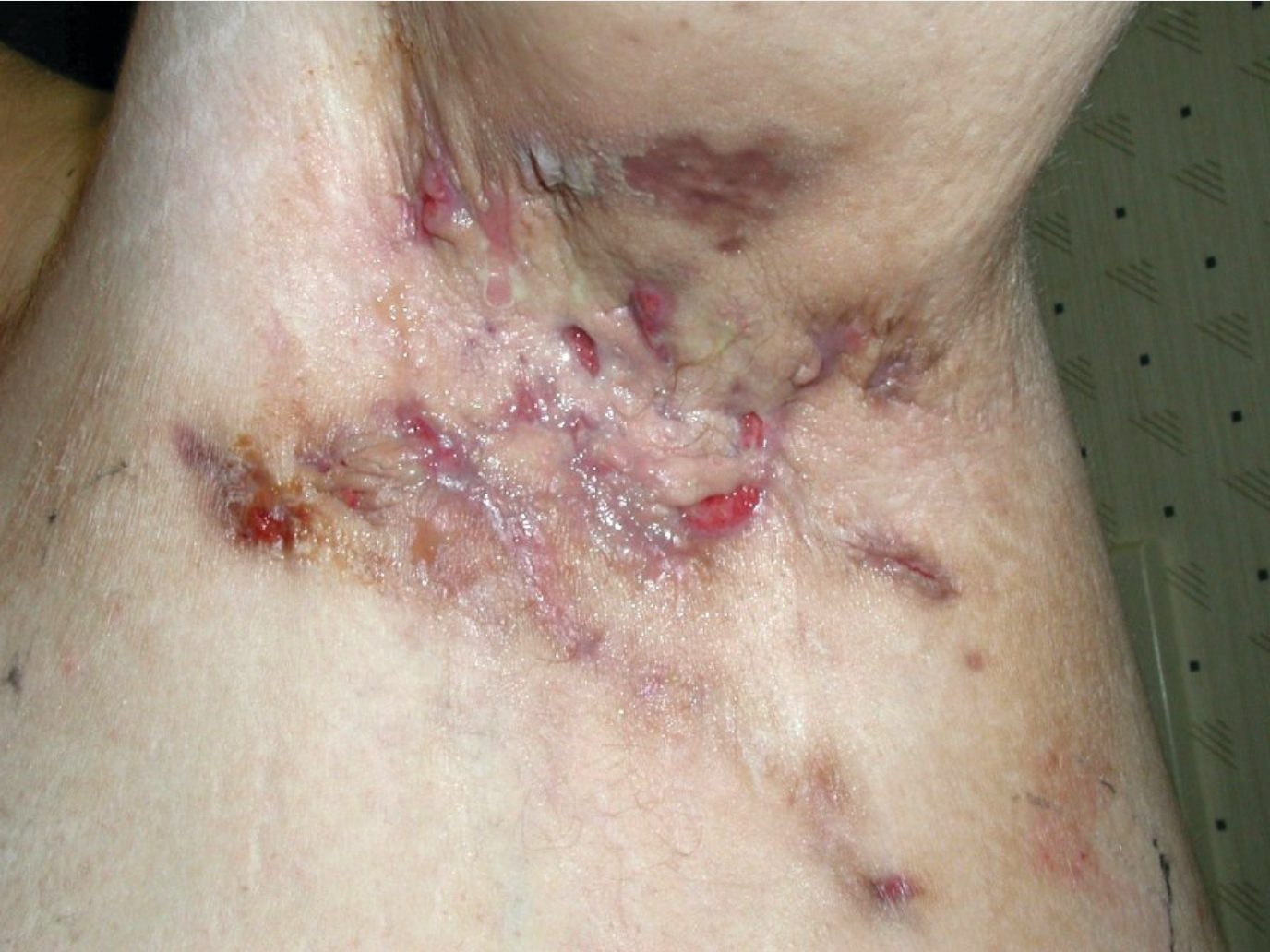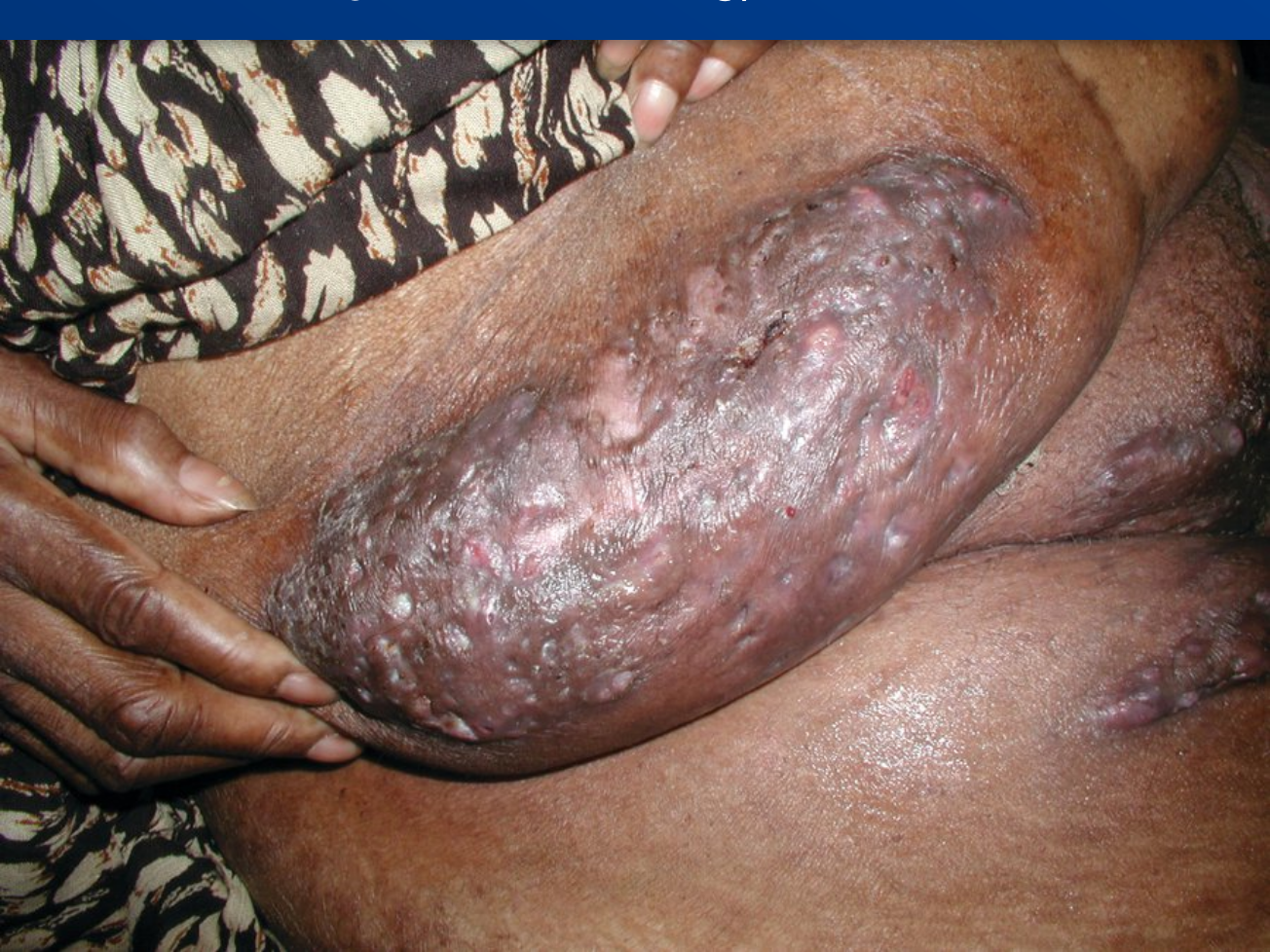Acneiform Eruptions
- related: Dermatology
- tags: #dermatology
Acne
Acne is a chronic inflammatory condition affecting the pilosebaceous unit (hair follicle and sebaceous gland). Although it is most common during adolescence, acne can affect people at any age. The clinical features of acne are open comedones (blackheads), closed comedones (whiteheads), inflammatory papules and pustules, and nodulocystic lesions on the face, neck, chest, shoulders, and back (Figure 27 and Figure 28).
Acneiform lesions are common, and the differential diagnosis is broad. Variations in distribution and primary lesions may provide clues to help differentiate acne from other diagnoses (Table 8). Finally, rapid onset of acne combined with other signs of hyperandrogenism such as hirsutism and oligomenorrhea warrants consideration of polycystic ovary syndrome, congenital adrenal hyperplasia, or an underlying adrenal or ovarian tumor.
The pathogenesis is attributed to abnormal keratinization within the hair follicle, excess sebum production (stimulated by androgens), colonization of the follicle by Propionibacterium acnes, and the release of inflammatory cytokines. Treatments are directed at all four mechanisms (Figure 29).
There are numerous classification and grading scales used for the assessment of acne. These systems are typically based on factors such as the number and severity of the acne lesions. There is no universally agreed upon system. A common grading system is to classify acne as mild, moderate, and severe. Mild acne consists of primarily comedones with few inflammatory papules and no nodules or cysts. Moderate acne involves several comedones and inflammatory papules. A few nodules may be present as well. Severe acne is characterized by large lesion counts involving comedones and inflammatory pustules along with several cysts.
Topical retinoids (tretinoin, adapalene, tazarotene) are first-line treatments for all types of acne as they are effective for both comedonal and inflammatory acne. Retinoids help normalize the keratinization of the hair follicle and are comedolytic, thus reducing follicular plugging. They also decrease inflammatory cytokines that are activated by P. acnes and reduce postinflammatory hyperpigmentation. Topical retinoids may cause erythema, burning, and dryness. All topical retinoids are contraindicated in pregnancy. Adapalene and tretinoin are classified by the FDA as pregnancy category C whereas tazarotene is pregnancy category X.
Topical antibiotics are helpful in inflammatory acne as they target P. acnes and exhibit anti-inflammatory effects. Because of increased antibiotic resistance, topical antibiotics should not be used as monotherapy. It is recommended that topical antibiotics be combined with topical benzoyl peroxide in treatment for mild, moderate, or severe acne. Topical benzoyl peroxide has bactericidal properties and is not known to promote the development of resistant bacteria. Benzoyl peroxide may cause irritation and allergic contact dermatitis in some patients. The common topical antibiotics clindamycin and erythromycin are pregnancy category B while topical benzoyl peroxide is pregnancy category C.
Oral antibiotics are frequently used for moderate to severe inflammatory acne and acne resistant to topical treatment alone. Oral antibiotics inhibit P. acnes and can also decrease inflammation. Tetracycline-based antibiotics are often used as they exhibit both of these desirable properties. Oral antibiotics should be limited to 3 months, when possible, to decrease the risk of antibiotic resistance. Tetracycline-based antibiotics are pregnancy category D.
In severe nodulocystic or recalcitrant acne, oral isotretinoin should be considered. The iPLEDGE program is an FDA-approved regulatory program to prevent birth defects from isotretinoin. Isotretinoin is pregnancy category X.
Adult acne is more common in women and is related to androgenic hormones. It typically presents along the jawline and often flares with the menstrual cycle. Combined estrogen and progesterone oral contraceptives are effective acne treatments for inflammatory acne in women and girls older than age 14 years without evidence of hyperandrogenism. The use of spironolactone, an aldosterone receptor antagonist with antiandrogen activity, can also be effective in the treatment of acne. Oral contraceptives or spironolactone should be considered as second-line therapy that can to be added to other treatments in women with moderate to severe acne. Oral contraceptives are pregnancy category X whereas spironolactone is pregnancy category C.
When counseling patients with acne, it is important to stress the importance of adherence to treatment and the time course for improvement, often several weeks to months. In addition to prescribed medications, only products labeled as non-comedogenic should be used for cosmetics and moisturizers.
Rosacea
Rosacea is an inflammatory condition that produces small pink papules and pustules on the central face in the third to sixth decades of life. Rosacea is most common among patients with light complexions from Irish and English decent. There are a variety of clinical presentations of rosacea including erythrotelangiectatic, papulopustular, phymatous, and ocular rosacea. This condition is defined by chronic inflammation of the pilosebaceous units with increased vascular reactivity. The pathogenesis of rosacea is still undetermined.
The papulopustular variant of rosacea can be confused with acne, but rosacea does not present with comedonal lesions (Figure 30). Telangiectasias are seen in the erythrotelangiectatic subtype (Figure 31). Most patients also have frequent flushing in response to triggers such as stress, alcohol consumption, heat, and excessive sunlight. The erythema of the cheeks can mimic the malar rash of systemic lupus erythematosus. Unlike lupus, however, the erythema of rosacea includes the nasolabial folds. Ocular rosacea may present in isolation or with associated skin findings. In ocular rosacea, the conjunctiva appears injected, and patients often describe a “gritty sensation.” In phymatous rosacea, severe sebaceous hyperplasia and chronic inflammation lead to fibrous overgrowth of the skin creating a nodular, tumor-like deformation of the facial structures. Rhinophyma is the form most frequently encountered, and it is almost exclusively found in men (Figure 32).
Treatment for rosacea is targeted toward the most prominent signs and symptoms in each patient (Table 9). Treatment of erythrotelangiectatic rosacea focuses primarily on behavioral modifications such as: avoidance of identified triggers of flushing, proper use of sun protection, and use of gentle skin cleansers. Treatment for papulopustular rosacea includes topical metronidazole, azelaic acid, and topical ivermectin. Topical glucocorticoids should be avoided. Oral antibiotics, such as low-dose doxycycline, have been shown to help control inflammation in ocular and papulopustular rosacea. This low dose decreases side effects and reduces the prevalence of bacterial resistance. Topical brimonidine and oxymetazoline are alpha-2 agonists, which can be used for temporarily reducing erythema in rosacea. Laser therapy (pulsed dye laser) is also effective for erythema and telangiectasias. In severe cases, isotretinoin may be used. In the case of severe rhinophyma, surgery is the treatment of choice.
Hidradenitis Suppurativa
Hidradenitis suppurativa is an inflammatory skin disorder of the apocrine glands. The pathogenesis of hidradenitis begins with follicular occlusion but not infection or inflammation of the apocrine glands. Following occlusion, secretions build up in the follicular duct and result in rupture and a subsequent inflammatory reaction that resembles a bacterial abscess. Following this, an acute inflammatory reaction is triggered in the surrounding tissue. The role of bacteria is controversial and is likely a secondary colonization since lesions are initially sterile, and antibiotics are not entirely effective in preventing new lesions.
This disease tends to occur more commonly in women and typically begins after puberty. Areas frequently affected are intertriginous areas such as the axilla, groin, and under the breasts. The condition is characterized by comedones, painful nodules, abscesses, draining sinuses, and scarring (Figure 33). Risk factors include obesity, family history, and cigarette smoking. For this reason, weight loss and smoking cessation are encouraged.
 Hidradenitis suppurativa often presents with tender subcutaneous nodules. The nodules may spontaneously rupture or coalesce, forming painful, deep dermal abscesses.
Hidradenitis suppurativa often presents with tender subcutaneous nodules. The nodules may spontaneously rupture or coalesce, forming painful, deep dermal abscesses.

Hidradenitis suppurativa is extremely difficult to treat. No single treatment has been effective for all patients; however, there are several options available, depending on the patient's presentation and circumstances (Table 10). Decolonization with dilute bleach baths and chlorhexidine washes may be used in addition to topical clindamycin. Common systemic treatments are oral antibiotics, such as tetracyclines or the combination of clindamycin and rifampin. Systemic retinoids and oral zinc gluconate have been used as well with limited evidence of effectiveness. Recently, the tumor necrosis factor α inhibitor adalimumab became the first FDA-approved treatment for moderate to severe hidradenitis suppurativa.
Surgery may be required for chronic hidradenitis suppurativa. This may involve incision and drainage or deroofing of painful abscesses and sinus tracts. Radical wide excision may also be used for refractory cases after other therapeutic options have been exhausted. Even after successful surgical treatment, recurrence is common.